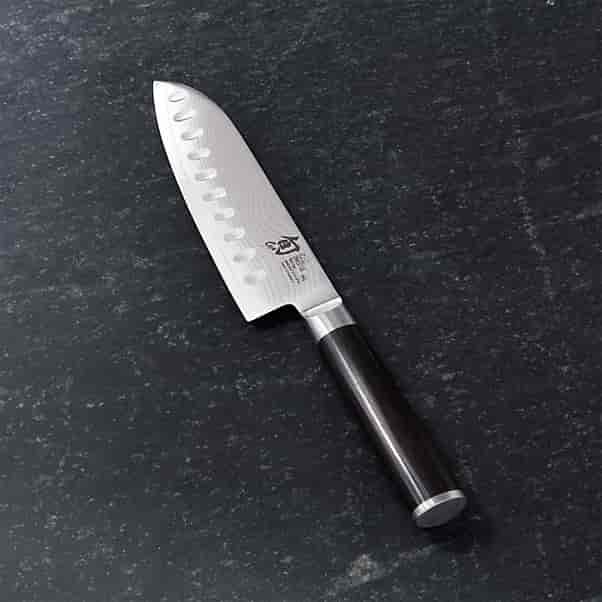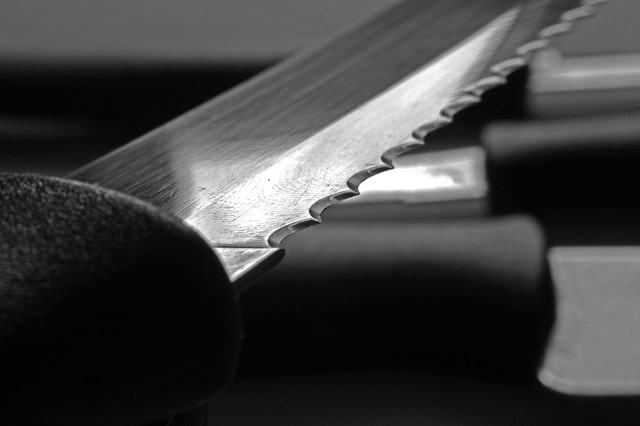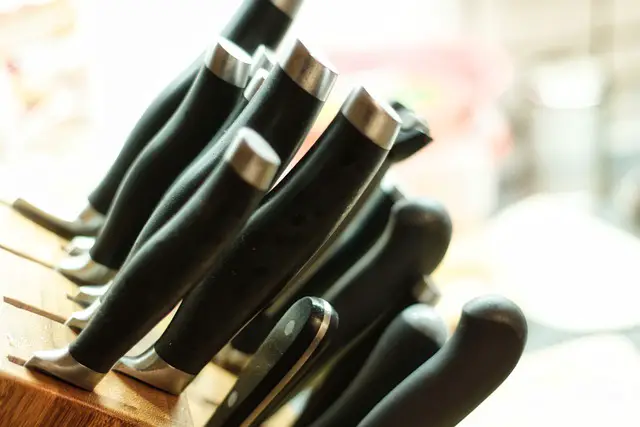When I was discussing the knife identification chart in a recent post, I mentioned the santoku knife too.
For those who haven’t read the post, this knife is one of the most versatile Japanese knives that you can have in your kitchen. That said, though, how do you properly use a santoku knife?
Today, we look at the blade that means “three virtues/ uses,” see what makes the blade amazing and understand how best to use it.
How about that?
Table of Contents
What is a Santoku knife?

The Santoku knife is a highly balanced Japanese knife characterized by the three activities that it is best used for: mincing, dicing, and slicing.
Like most things from Asia, the knife was made not only from an engineering perspective but from one of spiritual harmony and balance. I know how that sounds, but wait till you have one of these knives in your hand to understand how terribly well balanced this knife can be.
Sometimes, I think it was fashioned from the same material as Thor’s Mjolnir.
The versatility of the Santoku knife means that it can handle most of the kitchen activities by itself. Thus, you can get this knife and not worry about getting other kinds of knives for the specific activities that this one has completed.
If you are wondering how best to mix and match a santoku knife with other types of knives without purchasing a set, look at the kitchen knife identification chart to get an idea of what else you’ll need.
How to use a santoku knife in the kitchen
I found a really helpful video by Chef Jim Davis and he does know his stuff. I love the video not only because he discussed how to use the Santoku knife, but how the usage is different from that of the traditional chef knife that we all know.
In the video, you see how he uses the German chef knife in a rocking position as he cuts through the carrot. That could have been done with the Santoku knife too as he said, but that is not what the knife is made for.
Thus, you should put both knives in the right positions so that you get the best out of them.
Likewise, observe how he holds the knife. If you have spent some time around different knives, you will know that they are held differently.
One of these days, I should do a piece about how to hold different types of knives properly – depending on the blade and/ the purpose of the knife at that time.
What is a santoku knife best for?
Slicing, Mincing, and Dicing.
Those are the three main things that you should use a santoku knife for. If you are like me, though, and you like to get the best value for money, you can use your santoku knife for much more than that.
Honestly, why buy more knives when you can leverage a few to do all the tasks? That’s me, anyway.
You can also use your santoku knife to process small game, cut bread (don’t take it to the dining table, though), and cut steak where need be. Depending on other operations you perform with a knife in the home/ kitchen, your santokus could come in handy anytime.
What does a santoku knife look like?
This is a valid question for two reasons.
One, there are a lot of people who now prefer to use the santoku as a chef knife over the traditional chef knives, so it might be sold under another name to you. Likewise, there are different manufacturers out there with some choosing to add dimples to their santoku knives.

That could make things confusing (well, the dimples did confuse me). So, instead of trying to describe what these knives look like in their different forms with mere words, I’ve shown you instead.
There’s more on why you could consider these dimples (or not) later in the piece.
Do I need a Chef’s Knife and a Santoku?
First off, let’s see what you might need both knives for.
If you were getting a chef’s knife, that would be because:
- You are doing some complex cutting
- You would like to deliver versatile cuts across your food items
- You’ve got some cheese to slice
- Some vegetables and fruits are lying around in need of dicing and cutting and dicing
If you were opting for a santoku knife, what you might have in mind is:
- Slicing cheese also
- Cutting your meat into desired shapes and portions
- Dicing fruits and vegetables
- Slicing and mincing herbs
- Delivering some of the finest slices that even my mother would be proud of.
You can already see that both knives are similar in what they can be used for, even though they are not made the same – or from the same parts of the world either.
If you have been following CutsNCarves for some time now, you will know that I am always after getting the best value for money and not just buying it all. Left to me, I would choose either a santoku or chef’s knife and be done with it.
I am intentionally not being biased towards any one of both (I would choose the santoku knife though) because I want you to make your own choice. The truth is that I don’t think you can go wrong with any of these two.
If you need some more solid differences to help you make a better choice, know that the santoku is best suited to smaller hands, has a shorter blade length but delivers finer cuts than the traditional chef’s knife.
What is the best brand of santoku knives?
Zwilling (see on Amazon) makes some of the best Santoku knives on the market. After that, I have to give it to the guys at Imarku and Mercer also.
Even though the santoku is a Japanese invention, the knives are made from all over the world now.
I love the three brands above for the sturdiness of build of their knives and the quality materials that go into every one. That said, they are not the only brands in the niche. You can spend some time looking through others in your local store to get a feel of what they bring to the table.
If you were, say, ordering some Santoku knives online though, you should look for those three names and you would rarely go wrong. My mother approves.
What should I look for in a Santoku knife?
You would think that since they carry the same name, all Santoku knives come the same. That could not be further from the truth.
One of the best buying guides for the Santoku knife was designed by the guys at WorkSharpTools and I love their unique take on the subject.
According to them, make sure to look out for:
- Blade strength – some manufacturers try to shave cost or maximize profits for themselves by using inferior blade materials. Not the guys I mentioned to you up there, though. They always go for the best steel that they can get at the price range they bring the knife at.
- Blade thickness – a Santoku knife is not one to carry much bulk. It needs to be as thin as possible while remaining functional enough to slice through all the meat, vegetables, and fruits that you put in front of it seamlessly. Make sure to look at the advertised blade thickness before you put your money on any santoku knife
- Cutting angle – the santoku knife blade needs to be sharpened and pivoted at an acute enough angle to get the best piercing effects. Otherwise, you don’t get the best out of your santoku knife
- Blade strength – the fact that the blade should not be bulked up in width does not mean that it shouldn’t be strong either. A knife blade can either be strong or flexible, but a santoku knife blade must always be stiff.
Dimples are also a small consideration that can make a huge difference for you.
For me, I don’t mind that much but you might. If you had thought that these dimples are just on some santoku knives for the aesthetics you would be wrong. They are so designed to ensure food doesn’t stick to the side of the knife when cutting.
Although some food will still stick, but not as much as if the knife were not dimpled on the sides.
How do you sharpen a santoku knife?
If you have started using your santoku knife as well as I think you should, it would get dull at some point. Everyone who has ever handled knives knows that they are a beauty to use when sharp and could be a pain in the, err, behind, when dull.
Sharpening a santoku knife is a little bit technical because of the knife blade angle, design, and presence of possible dimples on it too. However, that does not make it impossible.
You can easily get your santoku knife shining and ready to cut against with a whetstone. If you haven’t used one before, here is a whetstone sharpening guide to help you through the process.
No matter what you do, never use an electric knife sharpener for your santokus. It might look like they make the work easier and faster but you would ruin your fine knife this way.
When it seems like you can’t get it done yourself, get the knife to professional sharpeners to do the work for you.
Final Words
We did start together to learn how to use a santoku knife and we have done so much more than that. From sharpening the knife to buying them right, you have all you need right here.
If there is something else that you need to know about the Santoku knife that I didn’t mention here, feel free to reach out via the contact form or in the comments and I’ll get back to you ASAP.
In the meantime, wouldn’t it be a fine idea to share this with your friends and family too? Friends and relatives that learn about knives together, stay together. Or something like that ha-ha.







